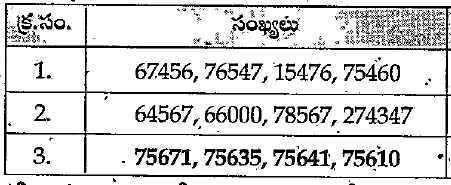కింది వాటిలో ఏది పెద్దది? 67లో 12వ భాగం (లేదా) 37లో 23వ భాగం
Step by step video & image solution for కింది వాటిలో ఏది పెద్దది? 6/7లో 1/2వ భాగం (లేదా) 3/7లో 2/3వ భాగం by Maths experts to help you in doubts & scoring excellent marks in Class 6 exams.
Updated on:21/07/2023Topper's Solved these Questions
Similar Questions
కింది ఆకారాలను ఏర్పరచడానికి కావాల్సిన అగ్గిపుల్లల సంఖ్య కనుగొనడానికి సూత్రం రాయండి. 'T' అక్షరాల అమరిక
View Solutionక్రింద ఇచ్చిన సంఖ్యలలో గరిష్ట మరియు కనిష్ట సంఖ్యలను గుర్తింగ్చండి. (3 వ గదిలో నీకు నచ్చిన సమయస్య రాసుకొని సమాధానమును రాయుము.)

View SolutionThe value of ((6^(-1)7^(2))/(6^(2)7^(-4)))^((7)/(2))xx((6^(-2)7^(3))/(6^(3)7^(-5)))^(-(5)/(2)) is
View SolutionWhich of the following in an orthogonal matrix [6/72/7−3/72/73/76/73/7−6/72/7] b. [6/72/73/72/7−3/76/73/76/7−2/7] c. [−6/7−2/7−3/72/73/76/7−3/76/72/7] d. [6/7−2/73/72/73/7−3/7−6/72/73/7]
View Solution2 1/7+3 6/7+5 1/6=
View Solutionf = {(2, 7), (3, 4), (7, 9), (-1, 6), (0, 2), (5, 3)} மேலும் A = {(-1, 0, 2, 3, 5, 7} லிருந்து B = {2, 3, 4, 6, 7, 9} க்கான.:சார்பு எனில், எனக் கொடுக்கப்பட்டிருந்தால் f ஆனது எவ்வகைச் சார்பு எனக் காண்க.
View SolutionFill in the blanks. 18 km h ^ (- 1) వడితో చలిస్తున్న వాహనం 1 s లో ప్రయాణించే దూరం _____m
View SolutionWhich of the following in an orthogonal matrix [6/72/7−3/72/73/76/73/7−6/72/7] b. [6/72/73/72/7−3/76/73/76/7−2/7] c. [−6/7−2/7−3/72/73/76/7−3/76/72/7] d. [6/7−2/73/72/73/7−3/7−6/72/73/7]
View SolutionWhich of the following is an orthogonal matrix ? ( ⎡ ⎢ ⎣ 6 / 7 2 / 7 − 3 / 7 2 / 7 3 / 7 6 / 7 3 / 7 − 6 / 7 2 / 7 ⎤ ⎥ ⎦ (b) ⎡ ⎢ ⎣ 6 / 7 2 / 7 3 / 7 2 / 7 − 3 / 7 6 / 7 3 / 7 6 / 7 − 2 / 7 ⎤ ⎥ ⎦ (c) ⎡ ⎢ ⎣ − 6 / 7 − 2 / 7 − 3 / 7 2 / 7 3 / 7 6 / 7 − 3 / 7 6 / 7 2 / 7 ⎤ ⎥ ⎦ (d) ⎡ ⎢ ⎣ 6 / 7 − 2 / 7 3 / 7 2 / 7 2 / 7 − 3 / 7 − 6 / 7 2 / 7 3 / 7 ⎤ ⎥ ⎦
View Solutionਕਿਹੜਾ ਵੱਡਾ ਹੈ:- 67 ਦਾ 12 ਜਾਂ 37 ਦਾ 23
View Solution323+512+635+725+3710=?
View SolutionMode of .2, 7, 5, 3, 7, 1, 6, 9, 7, 3, 6, 3 is
View Solutionकौन बड़ा हैं :
67का 12अथवा 37 का23
View SolutionWhich is greater:
12of67or23of37
View SolutionWhich of the following in an orthogonal matrix [6/72/7−3/72/73/76/73/7−6/72/7] b. [6/72/73/72/7−3/76/73/76/7−2/7] c. [−6/7−2/7−3/72/73/76/7−3/76/72/7] d. [6/7−2/73/72/73/7−3/7−6/72/73/7]
View SolutionWhich of the following in an orthogonal matrix
View Solution
